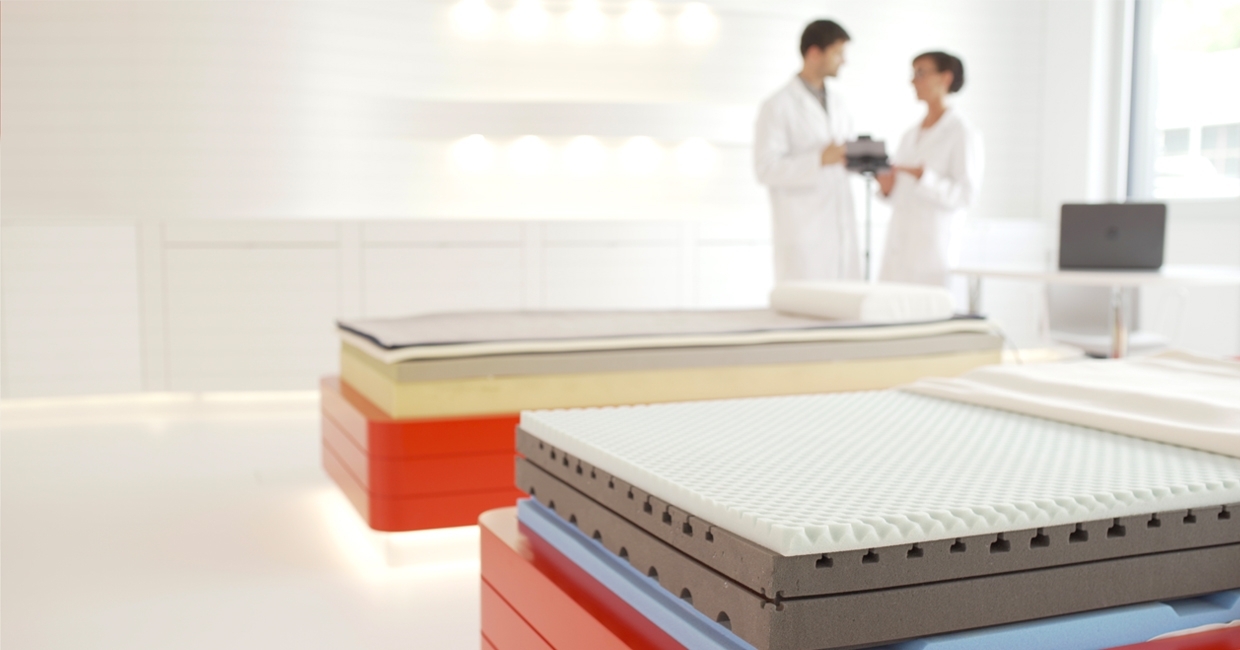Across Europe, some 30 million mattresses are thrown away every year – making their disposal/reuse a critical challenge for manufacturers and the environment. Material science pioneer Dow Polyurethanes developed RENUVA, a circular economy programme, to recycle end-of-life polyurethane products across various sectors in partnership with key stakeholders in the supply chain – and its work in the bedding industry thus far gives much reason for optimism, explains Dow’s EMEAI sustainability leader Lucie Porcelli, and global market segment leader, ComfortScience, Ricco Borella …
Can you summarise the RENUVA programme for bedding – its aims and key stakeholders?
Lucie: RENUVA is a circular economy programme which aims to recycle polyurethane foams from old mattresses back to raw materials to create new foam – for use, initially, in new mattresses!
We’re pioneering this in France and collaborating with key partners from across the product life cycle – Eco-mobilier (waste recovery experts), Orrion Chemicals Orgaform (chemical recycling operator), and Vita (foam manufacturer).
How much impact do old mattresses have on the environment, and what are your personal feelings around what the programme can achieve?
Lucie: For me, the environmental impact can be summed up in one striking figure – approximately 30 million old mattresses are thrown away in Europe annually.
That’s a staggering figure. The fate of an old mattress is to be either incinerated (emitting CO2) or dumped. We all want to see reductions here. I’m passionate about solving sustainability challenges like this, and for me RENUVA offers a truly pioneering approach.
Ricco: Absolutely. When designing the RENUVA Mattress Recycling Program, we wanted to find a solution to stop materials from going to waste so that we can keep using them long after they’ve outlived their useful life. We wanted to show that comfort can work hand in hand with circularity, and that there is no need to compromise on either.
How does demand for eco-conscious bedding credentials manifest in the various marketplaces you cover?
Lucie: All of us are aware of the impact we are having on the environment. Consumers are (rightly) demanding more sustainable products and less waste.
Let me offer the example of France, where our project is located. Demand for a more sustainable approach led to the establishment of a dedicated EPR scheme represented by the Eco-mobilier organisation – thanks to the participation of the bedding and wider furniture industry.
What are the tangible differences in the foam that is made through this process?
Lucie: Because this raw material has been created from recycled mattresses, new foam made from RENUVA products will ultimately provide brand owners with a more sustainable offering, without sacrificing durability, quality, or indeed comfort.
The C02 reduction (30-40%) achieved through these new processes is remarkable – can you provide any other headline figures that reflect what it achieves?
Lucie: We’re proud of this reduction. We are currently having the lifecycle assessment of RENUVA reviewed externally and look forward to publishing it soon, so we can provide more details. One of the most important achievements we expect is in terms of the volumes of mattresses the plant will process – we’re looking at a capacity of 200,000 mattresses per year. In the foam itself, RENUVA will replace up to 30% of standard raw materials with ones made from recycling.
What is Dow’s ComfortScience approach, and how does it manifest in partners’ products?
Ricco: ComfortScience represents Dow’s efforts to better understand, quantify, and ultimately improve individual comfort. To do so, we are taking a material science approach to a very subjective, psychological and personal subject.
We start by measuring three ComfortScience dimensions – ergonomics, microclimate, and sensation. For us, ergonomics is all about the fundamental body support a mattress and pillow need to deliver – which entails measuring the compression set to understand the durability of a given material and mattress construction over its life cycle.
Microclimate – where we consider how temperature and humidity move within materials, and how we can ensure the body’s temperature is just right during sleep – is getting a lot of market attention now.
I’d argue that sensation is the least-understood dimension. It’s difficult to quantify because it’s personal – but it’s also the most powerful. Within sensation, we look at parameters such as touch, feel, haptics, and initial micro-compression to understand how materials and constructions are experienced.
We integrate all this knowledge in what we call ‘sleep science’, and work with our partners and customers in the bedding industry to bring mattresses and pillows to the market that are more comfortable and respond better to individual consumer needs.
How are the programme’s benefits communicated to the end-consumer?
Lucie: Since the launch of RENUVA, we have sought to involve partners from across the product value chain. We are working with leading foam manufacturer Vita to both produce foam from the recycled material and help inform brand owners of the benefits of this programme. I’d encourage brand owners to get in touch with us and Vita to learn more.
Dow stresses that collaboration is a necessity in this kind of project. How do you work with partner manufacturers such as Vita to achieve your goals?
Ricco: Collaboration enables everything that we do at Dow, because we know that we can achieve so much more when we work together. In our ComfortScience Studios we have the capability to develop prototypes of finished products starting from the raw materials, and we do that with our partners to test new concepts and more. We’re committed to making a difference through the products we bring to market and through the relationships we build with partners.
Can you comment on the importance of the mattress retrieval process – do you have any involvement in reclaiming mattresses to be recycled, and might this be an issue in the UK?
Lucie: Expert collection is crucial to its success. In RENUVA, it’s how we source material that is ready for recycling. Our partner Eco-mobilier specialise in the collection and processing of used furniture – mattresses in particular – whereas our expertise at Dow is in material science and manufacturing products.
I’m confident that the success of RENUVA will inspire the expansion of EPR [extended producer responsibility] schemes elsewhere.
Is Dow looking at extending the programme to cover other areas of home furnishings, such as upholstery or cushions?
Lucie: The new raw materials created through the RENUVA process will be initially targeted for use in flexible foams for mattresses. They will also be suitable for use in rigid insulation foams.
But, like our project partners, we’re not lacking in ambition! We are keen to explore other applications in due course, and would love to hear from manufacturers and brand owners who may be interested in joining us in this exploration.
This interview was published in May's issue of Furniture News magazine. Read more about the latest bedding sector innovations here.










